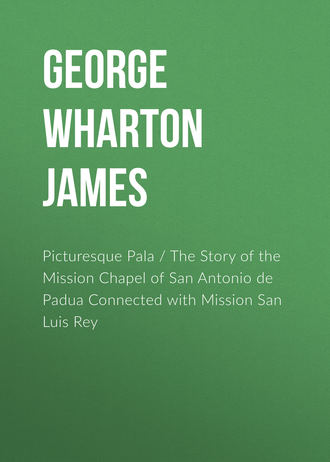 полная версия
полная версияPicturesque Pala / The Story of the Mission Chapel of San Antonio de Padua Connected with Mission San Luis Rey
Monte is a card game played by the older people and is much like faro excepting that Mexican cards are used.
Taking their lives all in all they are today very much like those of their white neighbors. The warriors of the passing generation and their squaws have thrown aside buckskin for gingham and shawls of cotton and wool. The thick-soled shoe has taken the place of the sandal or soft moccassin, but the springy tread of the foot is the same as it was when it traversed a pathless wilderness. The stoicism and the majestic mien, the indifference to results, and the absolute fearlessness which are expressed in every movement, are still essential influences in the life and government of the little band.
The younger men and women, while they tolerate with filial respect the superstitions of their fathers, are eager to adjust themselves to the ways and to be taught the arts and wisdom of their pale-faced conquerors.
CHAPTER XV.
The Collapse and Rebuilding of the Campanile
In January of 1916 a storm swept over the whole of the Coast Country of California from north to south, doing considerable damage on every hand. In the Pala Valley the rain fell in volumes. For twenty-four hours it never ceased, it being estimated that twelve inches fell during that time. The pouring floods swept over the valley, and soon began to undermine the adobe foundations of the tower. The base was simply a piled-up mass of adobe, covered with cobble-stones, which, however, had withstood the storms and the earthquakes of a hundred years. As soon as a few of these cobble-stones were removed by the flood, the clay beneath began to wash away with startling rapidity. Nothing, however, could be done to prevent the rushing torrent that eagerly ate away the ever-softening clay, and at three o'clock in the afternoon of January 27th, those who watched with bated breath, anxious hearts, and prayerful longings, were saddened by seeing the more solid part of the base drop apart, thus removing all support to the tower. The next moment it toppled forward and fell with a splash into the muddy water surging at its feet. As it fell it broke into several pieces, but, fortunately, the bells sank into soft mud, and were afterwards found uninjured, to the delight of pastor, Indians, and all the inhabitants of the country around about.
What now should be done? Had the Indians been alone there is little doubt but that their love for the interesting and historic tower would have led them, unaided and alone, to reconstruct it. But in their pastor, the Rev. George D. Doyle, they had one upon whom they have long learned to rely as a real leader, in all things pertaining to their welfare. Father Doyle at once put himself in communication with friends throughout the country. In San Diego he appealed to Mr. George W. Marston and Mr. Thomas Getz, the former one of the most public spirited benefactors of that city, the latter being well known for his interest in the Missions, from his exhibit at the Panama-California Exposition and his lectures on the same subject at "Ramona's Marriage-Place," at Old San Diego. These gentlemen immediately undertook to raise at least one-fifth of the amount estimated for the Campanile's repair. Other friends responded nobly, and the work of rebuilding was immediately begun.
It was the substantial gift, however, of Mrs. George I. Kyte, of Santa Monica, Calif., that made it possible to complete the work in so short a time.
A solid and substantial concrete base twelve feet long, twelve feet deep, and five feet wide, was first erected, so that no storm of the future could undermine it. Then carefully following the plan of the old tower, using the old material as far as possible, and not neglecting a single detail, the new tower slowly arose to its completion. The old cross-timbers for the bells, were again given their sweet burden, the original cactus saved from the ruins was planted again at the foot of the cross, the cobble-stones of the base, also, were put back into place and neatly white-washed. Hence, except that it looks so new, Padre Peyri himself would not know it from the tower of his own erection
1
In and Out of the Old Missions, Little, Brown & Co., Boston.

